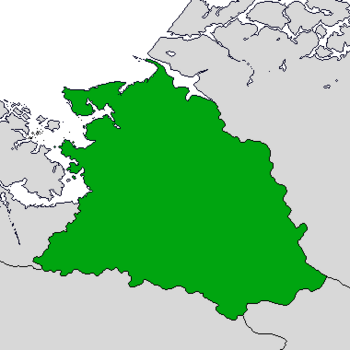Ariseo
This article is incomplete because it is pending further input from participants, or it is a work-in-progress by one author. Please comment on this article's talk page to share your input, comments and questions. Note: To contribute to this article, you may need to seek help from the author(s) of this page. |
The Empire of Ariseo アリ瀬尾帝国 | |
|---|---|
| Motto: "永遠に咲きなさい、私の帝国" "Bloom Forever, My Empire" | |
| Anthem: "Imperial Anthem of Ariseo" | |
 | |
| Location | Map of Ariseo |
| Capital and largest city | Hyeangseul |
| Official languages | Teihyogengo |
| Recognised national languages | Xinminese, Uulkythian, Shanirin |
| Recognised regional languages | ) |
| Ethnic groups (1612) | 65.4% Arinese
23.7% Xinminese 4.40% Uulkyth 3.14% Shanirin 3.36% Other |
| Demonym(s) | Arinese |
| Government | Unitary Parliamentary Semi-Constitutional Monarchy |
• Empress | Subaika |
• Prime Minister | Miyazaki Noriyuki |
| Legislature | Imperial Parliament |
| Imperial House of Peers | |
| Imperial National Assembly | |
| Establishment | |
• Establishment of the Imperial Dynasty | 422 AR |
• Meiru Constitution | 1600 |
| Population | |
• 1612 estimate | 121.4 Million |
| GDP (nominal) | estimate |
• Total | $4,125,414,800,000 |
• Per capita | $33,982 |
| Gini (1612) | 39 medium |
| HDI (1612) | 0.911 very high |
| Currency | Arinese Yen |
| Date format | dd/mm/yy |
| Driving side | left |
| Calling code | +85 |
Ariseo (Teihyogengo: アリ瀬尾, Ariseo and formally アリ国, Arikoku) and officially called the Empire of Ariseo is a country located in the continent of Pythia. It borders the Dze Confederation to the west and is within proximity of several other nations. With an estimated population of 121.4 Million people, it has a estimated land size of 1.5 Million kilometres² with over 2,000 islands littered around its coast. The Great Fjord, a bay that is shared with the Dze is apart of the calmer waters on the edge of the Wintry bight.
Densely populated on its coast, the geography of Ariseo stretches from warm boreal coasts to the warmer bays, and the cold and harsh Guojia Desert that spans much of the countries south. The population has therefor been concentrated into urban centers that snake along the coasts and amidst the mountains of Ariseo, though a good portion remains spread out across the countryside amidst its ongoing population boom.
The region of Ariseo was resettled around year 100, with the first Kingdoms and feudal states having entered into written documents in the form of the Ariya Dynasty around 200 AR. As one of the earliest dynasties in the region, the peoples of Ariseo compromised of the Arinese people which originated from the western regions alongside the Xinmin peoples of the east, forming various kingdoms and later regional dynasties in Ariseo. Influenced by their neighbours, the eastern regions enjoyed much diversification with its population of elves. The unification of Yeongrang as one Imperial Dynasty under the Mugunghwa Throne in the 4th century saw the expansion and later unifications of the borders of Yeongrang by the 10th century after a series of conquests, and expeditions from the Golden River area where the Imperial Dynasty was first located.
Despite this, the Mugunghwa Throne suffered from a steep decline of influence during the latter centuries onto the 13th to 14th Centuries, where the Sengoku Jidai of Ariseo saw the Thrones power be usurped by the "Control" Clique of Ariseo, a cabal of military officers that turned the nation to a hereditary military dictatorship and divided amongst Bakufu's. This state of affairs continued with the Shogunate increasing its control over the country until the 16th Century, where control rapidly slipped upon the installation of a child Shogun which saw various houses clash and later divide the nation into areas of control. However, around the 1520, the nation faced an unprecedented technological upbringing in the formation of various Zaibatsu's across the nation, exploiting the new introduction of alien technology onto the world. These technologies were studied extensively, and either reverse-engineered or improved as time went on, leading to the start of the Arinese Industrial Revolution by 1533, with the 2nd Industrial Revolution occurring rather recently in 1604 with the expansion of the Internet-of-Things, Aritficial Intelligence, Robotics and the introduction of modular factories. The largest of such houses, the House of Koshu, would spearhead under the legendary statesman Otonari Akihiro up until his death to lead the Subaika Reformation which continues to this day. Restoring the power of the Imperial Throne and beginning an era of reform, renewed militarism and nationalism.

